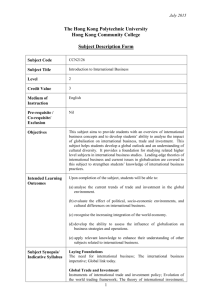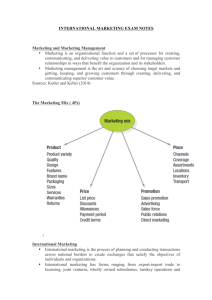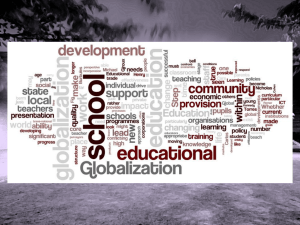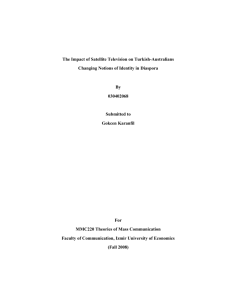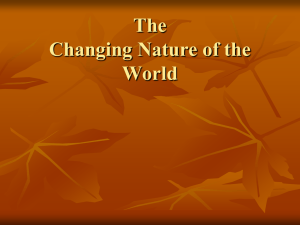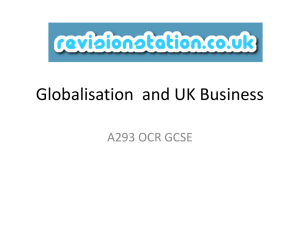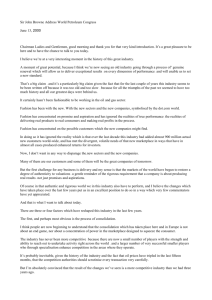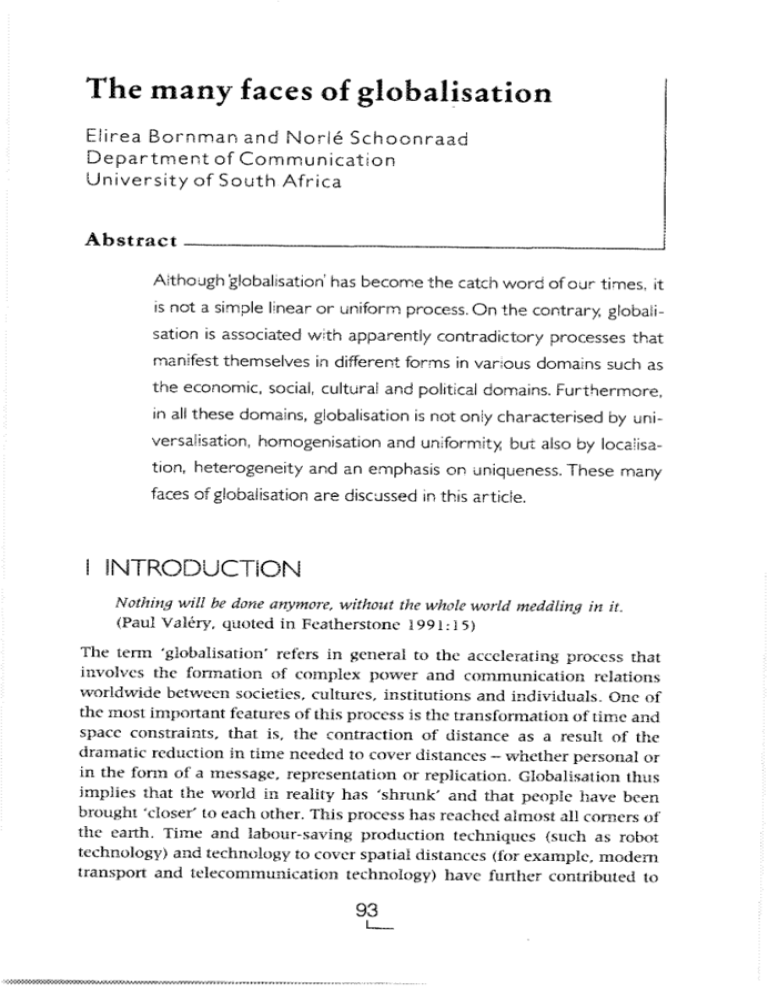
The many faces of globalisation
Elirea Bornman and NorI6 Schoonraad
Department of Communication
University of South Africa
Abstract
Aithough 'globalhsation has become the catch word of our times. it
is not a simpDle iknear or uniform process. On the contrary, globalisation is associated with apparently contradictory processes that
manifest themselves in different forms in var.ous domains such as
the economic, social, cultural and political domains. Furthermore,
in all these domains, globalisation isnot only characterised by universalisation, homogenisation and uniformity but also by loca'isation, heterogeneity and an emphasis on uniqueness. These many
faces of globalisation are discussed in this article.
I
INTRODUCTION
Nothittq will be done anymore, without the w,4hole wvorld meddling in it.
(Paul Valery, quLoted in Featherstone 1991:1 5)
The termii 'globalisation' refers in geineral to the accelerating process that
involves the formation of complex power and commtnicationi relations
worldwide between societies, cultures, institutions and inidividuals. One of
the most important features of this process is the transformation of time and
space constraints, that is, the contraction of distance as a result of the
dramatic reduction in time needed to cover distances - whether personial or
in the fonn of a message, representation or replicationi. Globalisation thus
implies that the world in reality has 'shrun<k' and that people have been
brought 'closer' to each other. This process has reached almnost all cornlers of
the earth. Timne and labour-saving production techniqtues (such as robot
techrnology) and technology to cover spatial distances (for exarmple, modern
transport and telecommunication technology) have further contributed to
93
the spread of modern ideas, technologies ancd organisations of the European
and North American centres to virtually all corners oi the eartlh
(Mohaminadi 1997:3, 128; Toinlinson 1997:170; Waters 1995:3).
The compression of time and space distances also induced the intensification of awareness of the world as a -whole. Apart friom the objective reality of
globalisation, there is therefore also a subjective dimension that relates to
the increase in awareness among people thal they form part of the global
set-up (Robertson 1992:8).
Hoxever, globalisation is an intricate and multiple process. In the first place
two dimeTnsionis - a horizontal and a vertical dimnension - can be
distinguished. The horizonltal dimension involves the progressive comnpression of time andl space that culiminates in the world becoming a unified
place, a single systemn. The vertical dimension involves a twofold process.
onXthe one hand there is a tendency to homogenise. synclironise. integrate,
unif'y and universalise. On tle otlier hand there is a tendency to localise,
differentiate, diversify and particiilarise. Although various analysts
acktiowiedge the existence of these apparenitly contradictory processes,
little is known about their link with each otlier. Yet it is generally accepted
that these processes are essentially interwoven and - as two sides of the
samne coin - actually represent two manifestations of a single process
(Tehranian & Tehranian 1997:13 1). Bramran and Van Staden (2000:3)
therefore prefer to use the plural form 'globalisations' to indicate that
globahsation is a multiple process that can be observed in mnore than one
area, experienced differently in differenit areas and manifest in a variety of even contradictory - ways. The multiple nature of globalisation can
however be tnderstood better if onie takes a look at its realisation in
various domains.
2 THE ECONOMIC DOMAIN
EconIomiic globalisation can be defined as a process in which economic
activity occurs progressively on an international level. Economic globalisalion is characterised by an ever-stronger liberal approach to international
trade in goods and services, as well as by the international flow of capital
(Clien, Hule 8EStocker in Chien 1998:2). This means that obstacles in the
form of trade restrictions between countries are reduced, anid in some cases
totally removed.
As a result of economic globalisation an integrated and unliimiited market
develops for all commiiodities. Ati integrated market d(oes riot mean that
94
__w
there is one world market only, but that economics and markets of cotntries
become increasingly interdependenit. No mnarket or economy can operate in
isolation any longer. As a restult of the rapid development of infonnation
and communication technlology, geographic bordiers and time differences
cease being a limiting factor in international trade and finance and an
uLnlimited or virtual mrarket cemierges. Commodities are anythinig that can be
exchaniged, borrowed, purchased or sold, and incltude money, physical
products and services, and information. ilamelink (1994:110) describes
economnic globalisation as the emnergence of global consumrers who demand
global services and products that are provided by global distributors.
2.1 Facets of economic globalisation
Two distinct facets of ecornoniuic globalisation can bc distinguished:
2J.1. An increase in international trade
Waters (1995:66) regards trade as the foundation of globalisation as it has
the potential to bring producers and consuirlers who are geographically
removed from each other into contact. From the earliest times rmani engaged
in trade, but international trade started expanding rapidly during the
industrial revoIlution in the n ineteenth century. Ruggiero (1997:16-17)
describes three phases througlh which the world economy proceeded after
the Second Worl(i War. The first phase - which Ruggiero namned the
intemnationalecon?omy- took ulp the first three decades after the Second World
War and was marked by an increase in trade between a grouip of national
economies or nation states. The period 1970 to the late 1980s was marked
by rapid technological advances and a systeinatic reduction in trade
restrictions. This enabled businesses to establish different facets of their
prodtiction in differernt parts of the world that, in tum, leads to the
cstablishment of so-called transnational or mrultinationial enterprises. World
trade was conisequently rio longer restricted to transactiolns betwveen nation
states - a global econony has emerged. Currently, mutiltinational enterprises
are responsible for about two-thirds of world trade amid are regarded as the
locus of transnational econommiic activities.
A third phase, thle unlitnited econiomy, was introduiced by the development
of digital technologies and commluirnication networks in the late i 990s. As
geography, borlers and time no longer fonned significant barriers to
international trade, an unlirnited word econorny was established. Trifonnation has become the most important cotnmiodity, and free and equal access
95
w_
to it has the potential to bring more balance into the relations between
cotntries.
2.1.2 The globalisation of financial markets
In the ulnliimitedt economy in wvhich we find ourselves currently, the flow of
capital is no longer limited by geographic or time barriers. The circulation of
money progressively occuis outside of the jurisdiction -of national
governments (Haielink 1994:108). We can also refer in this regard to a
vinual financial m-arket. Rastogi (1997:48) identifies three driving lorces
behincd the globalisation of financial markets. Firstly, the worldwlvide
deregulation of trade and financial markets results in most countries
raising various regulations that restrict the flow of commo(lities as well as
capital to and fromn thef. in other words, cotuntries open their economies or
make them mzore accessible. Advances in computer and communication
technology have furthermore facilitated and accelerated the flow of
information on which transactionis in the financial markets are based.
Financial transactions are nowadays virtually clilched in the space of
milliseconds. Infomiation on financial imarkets is available 24 hours per
day, worldwvide, and xvhen changes occur. infonnration is inistantly updated
accordingly. CNN,-FN (Financial News) is an international television
channel and Bloomberg Financial Markets provide financial i'nfo:nnation
via comnputer networks, radtio, television and the printed media (Howard
1998:48). Diverse developiiients such as the formation of free trade zones,
the denmise of comnmunismn, the switch-over to fluctuatinig exchange rates,
the aging of the world population, the growtl of the middle class in
developing countries, and the reconfiguration of pension schemes also lead
to an increasing supply of and demand for capital.
However, there are some obstacles that the tnlimited economy still has to
overconme, such as legal, accounting and tax differences between countries.
Furthermiore, not all countries arc equally keen to deregulate their
economnies. According to Rastogi (1997:50, 53) these obstacles may delay,
buit will Inot prevent, the globalisation of financial nmarkets.
2.2 The driving forces behind economic globalisation
What induced economnic globalisation andi still accelerates
important driving forces can be identified:
96
___
it? Four
2.2.1 The economic theory of demand
Hu and Griffith (1997:117) as well as McClemients and Smallmnan (1998:5)
regari the economic theory of demand as the foundation of globalisation.
Internationial trade (goods as well as financial transactions) started to
increase supply in answer to the growing demand for goods, services,
capital and information.
2.2.2 Economic integration
Econionic integration is supported by the formation of' economiic regions
such as the European Union (EU), the North American Free Trade
Agreement (NAFTA), and the Asian Pacific Economic Cooperation (Hu &
Gnriffith 1997:118).
2.2.3 Technological development
Technological development, especially communication techncology, facilitated and accelerated econoomic globalisation. Developments in telecomnilunication and mass media have resulted in the exposure of consumiers right
across the world to nev/different standards of living. This has resulted in
the emergence of a global conswmer market with similar needs (Hu &
Griffith 1997:118). Technological progress also made possible./facilitated
the globalisation of financial markets.
2.2.4 The decline in the influence of the nation state
McClements and Smallman (1998:3) refer to a fourth factor that accelerates
economic globalisation: the decline in the influence of the nation state. This
aspect of globalisation is discussed in more detail in the section on the
political domain (Section 5).
2.3 Threats and challenges associated with economic
globalisation
2.3.1 The ripple effect of crisis situations
A major threat associated with the unilinited economy (where a group of
countries conduct trade, lend and borrow moniey and engage in investments
arnong themselves) is that when one country or region plunges into an
economic crisis, the effect of the crisis can spread worldwide. A good
example of this is the Asian economic crisis that began during 1997. This
crisis was mnarked by dramatic falls in the values of monetary units and
97
economic growth rates in countries such as Thailand, Indonesia, the
Philippines, Malaysia and Japan. The crisis was a major shock for Asia and
the rest of the world because unitil shortly before Asia was regairled as the
world's fastest growing region. It was eveni feared that the Asian crisis could
result in a worldwcide econiomic recession - that the 'Asiain flu' could
become a worldwide epidemic.
OIIe of the causes of the Asian crisis was that many of' t:he South Asian
countries had under-developed local financial systems. In other words, the
requisite financial infrastruictLure (e.g. a highly developed bank system) for
complying with the demands of the increasing international trade did not
exist. This not only led to instability in the Asian inarkets, but destabilised
the world imarkers loo. [he impact of' the crisis was felt by developing
countries in South America and Eastem Europe as well as Russia (Aggarwal
1999:392-398). Perum lor instance, exports zink, copper and tin to South
Asian countries. As a result of the Asian crisis these exports fell
considerably (AInonymous 1998). Even developed countries in North
America and Westent Europe were affected by the crisis.
Another example, closer to our owIn soil, is the recent economic an(i
political crisis in Zimbabwe. It did Inot only impair Zimbabwe's economy,
btut also had a very negative effect oni the South African economy. The Rand
weakened considierably against the American Dollar and British Pound, andl
investor confidence in Southern Africa declined.
2.3.2 Over-production
One of the challenges of the increase in internationial trade is the balancing
of supply and demand (Smith 1998:125). A growing ntmiber of companies
start to focus on production for the intertnationial market but overlook
demand. This results in supply exceeding demand worldwide. An example
of this is the mnotorcar industry: Grieder (in Howard 1998: 50) points oUt that
the total supply by motorcar mainufacturers in the year 2000 will reacih 79
million vehicles worldvride, althougi trie worldwNide demarnd will bc for 57
millioni vehicles only.
2.3.3 Competition
'fThe greater opeminess of the unlimited ecoilomiy stimulates competition
from upcoIniing cotunitries in Asia and South America, vhich competition
increasingly threatens thc economnic doiminanice of the USA and Europe.
98
__
2.3.4 Labour
The idea behin multinational companies is, amongst others, to shift
production to countries where labour is rrmuch cheaper. However, this is
often accompanied by large-scale exploitation, so that multinational
enterprises have increasingly been pressurised frorim various quarters to
improve the working conditions of the labourers at their overseas plants.
2.3.5 Global leadership
The decline iI the influence of' the nation state has already been referred to
in the discussion of the driving forces behind economnic globalisation.
Despite the fact that the world is dominated in the economnic sphere by a few
multinational giants, this domination does not occur within an ethical
frameAork. Most of these enterprises operate in their owln interest only.
2.4 Critique on theories of economic globalisation
Although the idea of econcimic globalisation is recognised worldwide, there
arc also people who are sceptical about it. The debate deals in particular
with the real extent of economic globalisation. 'rhe results of a study by
Kleinknecht and Ter Wengel (1998:637) diraw attention to the tendency in
international trade to occur to a great extent within trading blocks (e.g. EU,
USA and Asia) and not between trading blocks. One can easily err in
thinking that economic globalisation means that all countries of the world
trade with all other countries. Economic globalisation means that markets
worldwide have become more accessible, and this accessibility is still
growiing, but a totally integrated world economy is still a long way off.
3 THE SOCIAL DOMAIN
3.1 The so-called 'globalvillage'
In, the past, social relations and the concept 'community' primuarily referred
to face-to-facc comniunication and interaction between people within the
same geographic space. This conmiiuxnication mainly centred oII matters of
local interest and was facilitated by a local cotmmunity cultulre. Examples of
such interaction are getting together at coffee bars; interaction on the village
sq(uare; and shaking hands, within view of all the parties involved, to
confirm that a contract has been close(l.
99
Today neither dialogue nor interaction nor the communiity is required to
share the saimie geographic space. The compressioin of time and space that
coinIcides withl globalisation also results in a re-organisationi of' social
relations. Nowadays social relations in fact extend across the globe. This
means that commiunication relations are no longer limited to a particular
place. bust are globally/spatially extended. We have all in reality beconme a
part of an unlimited commutnity. The existence of this community, which is
not constrained by distance, interstate borders or other physical obstacles, is
made possible by modern comnmuniication technology that maintains
cormimunication relations - regardless of timre or space.
Social giobalisatioii implies that Marshall McLuhan's (1 964) conceptualisation of the world as 'a global village' is in certain respects indeed
niaterialisinig. Frederick (1993:119) does however point out that McLuhan
was over-idealistic. He believed that t'he wonders of electronic comnmtinication would lead to the disappearance of all social, ethnic and racial
divisions and eventually create a homogeneous global society. According to
Frederick, communication irn the global village differs from that in a local
media is often impersonal, of
context. Communication via the clect-ronic
short duration, anonymous and mneostly indirect On the other hand,
commnunication within thie local context is characterised by personal contact
and initeraction. it muist further be noted that the daily life of most people,
despite the fact that they are aware of their being part of the global set-up, is
bouLnd to their local geographic space. They incorlorate elements of other
societies and the global society into their personal lif'e in their local space.
3.2 The fragmentation of identity
An iimlportant ef'fect of social globalisationi is the fragmentation of
individual as well as social identity (also called 'groutp identity'). People's
id'entity is fonned by fragments that originate at different levels. These
levels range from the local to the global. Hence there does not exist in real
life a pure global or a pure local identity. Rat:her, people's identity is a
complex blend of global and local elemenits. Within the local space peo ple's
individual arnd social identities are also continlously formied and re-funned
by the incorporation of elemnillts originating from the dif'ferent levels. The
paradoxical phenomena of heterogeneity, differentiation and particularisation - and in paiticular the rise of ethnic solidarity - that are discussed in
Section 5, lead scholars to doubt wrhether, at this stage, one can really talk of
the establishment of a single humnan awareness or identity.
100
3.3 The global versus the local
Social globalisation has furthermore resulted in local events being
influenced by events that occur at places even thousantds of miles away.
The relations that: dominate our everyday life consequtently shift fromrn the
local to the global context, because the local context is interpreted againist
the broader global framework of time and space. The opposite is just as true.
What occurs locally can exert an influence on locations that are literally oiI
the other side of the globe (Frederick 1993:7; Toinlinson 1997:171).
Giddens (1994) talks in this regard of 'actioni at a distance'. A good example
of this phenomTtenon is the way in which negative perceptions of Africa in
the rest of the world exert a negative influence on investmiients and
economic development in Southi Africa. The perceptions and actions of
people who live hundreds - and even thouLsands - of kilonmetres from wlhere
we live do consequently greatly affect our lives.
3.4 The formation of a global civil society
Globalisation further led to the establishrrient of a global civil society. Civil
society can be defined as those societal activities that fail outside of the
economy and politics, but are signif'icantly affected by economic and
political realities. Before modem technology made conmmunication relations
across time and space borders possible, the civil societies of the world had
difficulty to unite in broader alliances. The new techlniology promnotes,
however, co-operation between a variety of tdie world's non-govemmenital
and non-profit organisations (the so-called NGOs) in a wide variety of
spheres such as human rights, con sumner issues, conflict managemient.
women's rights, racial equality and environmental conservation. Global
mobilisation arotund these issues rests on the assumption that we are all
inhabitants of Planet Earth, that is, mnemiibers of the global social
commtnity, and that transgressions in any of these spheres affect all of
us deeply. This significant development in the history of humlan
communicationr has already hadi a powerful impact worldwide on social
amid political movements (Frederick 1993:7; Waters 1997:101). Tlhe fuLss
that the 'Green' movement in Europe makes about the culling of' elephanits
in the Kruger Park is but one examnple of global social niobilisation around
nature conservation issues.
101
4 THE CULTURAL DOMAIN
4.1 Processes associated with cultural globalisation
The horizontal and vertical dimensions of globalisation can noWhere be
observed better than in the ctldtural domiiain. Ihe cultural situation of the
wvorld is intrinsically linked with the flow of information and knowledge
that in themselves can be designated as cultural flow. However Appadurai
(1990:2) distinguishes processes that have an impact on culture - global as
well as local. These processes are the following: the flow of individtuals
(tourists, migranits, refugees, etc); the spread of technology; the spread of
capital; the spreadi of information; as well as the spread of political values
and ideas (for example, ideas oni freedom, dernocracy and hiuman rights).
Waters (1995:126) addts to these the spread of religious values and ideas.
4.2 The emergence of an universal consumer culture
It was long believed that the increase in the flow of infornation - and in
particular the introduction of the Internet - would lead to the establishment
of a homogeneous world society and culture. It is indeed so that there is
currently talk of the worldwide establishiment anid spread of a hiomogeneols
Americani-Westerni consumer cultture (Teliranian & Tehrainian 1997:132;
'Western cultural
Waters 1995:140). Tennis such as 'Americanisationi'
often uLsed in this
are
world
the
of
imperialisim' and the 'Coco-Colanisation'
regard.
The spread of thlis conisumner cultlure is promoted by the enormous growth in
world trade anid the concurrent spread of publicity for the mass market; the
rapid development of communication technology aind other technological
innovations; the nmass media (and people's tendency to initate depictions
and actors in the mass media); the worldwide spread of electronic
entertainment presented by a few mega-conglomiierates; the spread of
coommercially packed cultural products such as food (for example, CocaCola and McDonald's harriburgers), clothinig (for example, Calvin Klein
denims and Nike sport equipment), poptldar mnusic and mzany more. The
establishment of a uniform consunmer lfestyle that is propagated aggressively worldwide by advertising is fiurther facilitated by a liberal political
climate. A further conseqtuernce of the coiisumer culture is the popularisation of so-called 'high' and 'elite' cultural products. A good examiple is the
concert of the three tenors during the world soccer event in 1992 where
opera imlusic was linked to popular sport. The fomi of tlhe concert was also
102
-_w
rather that of a pageant (probably ainmed at the mass media) than that of a
classical music concert.
It is however irmportant to note that the term 'consumlner culture' implies
more than the inere use or consumption of particular goods and services.
The items and goods at issue do not only have material value, but also
achieve syrnbolic meaniing. The consumer culture originates front intluential groups who in their capitalist drive encourage consumers to 'desire'
things they may not really 'need'. Consumption therefore becomes a way in
which the individual expresses hinmhersei' and defines his/her identity.
Both the need structure and the self-image of individuals are thus
transformed, while consumption is directly associated with identity.
Sources of social differentiation such as descent, class and political
aff'iliation are also greatly replaced by concepts such as 'fashion', 'taste'
and 'lifestyle'. One's place and esteem in society are theretore determiined
by the extent to which one reflects the latest fashion fads and lifestyle of the
consumer culture. The saying 'fine feathers make fiine birds' indeed
assumes a new nmeaning in the global cultural set-ilp.
4.3 Cultural imperialism
The termi 'cultural imperialismr' is often used to refer to the honiogenising
influenice of the global consumer culture, that is, the equalisation and even
extermination of local culttires as a consequence of the worldwide spread of
the Western-American lifestyle and the values and consumLer goods
associated withl it. According to the discourse of cultural imperialism, one
of the most importaint implications of this cultural equalisation is the
reduction of the space in which local communiities can practise their own
culture. (The ability of a local commnunity to develop anid maintailn its own
culture depends to a great degree on the local cultural space that that
cominmunity controls.) Local initiative is however stuppressed and the
production of local cultural products is imnpaired. The local culture is
ihdeed silenced. According to this view the process of cultural globalisation
ultimately boils down to the predoimiination of Western modernisationr and a
particular riational culture, namely the American culture. A dramatic
pessimist scenario is fturthernore pictured of the Third World, which
scenario asserts that the cu:ltures of these parts of the world are virtually
being fully absorbed by the homnogeinised and commercialisecl global
culture.
However, the discourse of cultural imperialism is currently widely criticised
for various reasons. On the one hand this view represents a otne-sided and
103
deterministic perspective on cultural processes according to whl:ichi the local
culture is totally detennineed fronm above by political and econiomnic realities.
Cultural processes are thius regarded1 as a onie-way flow of power from the
American and European cultutral cenitres to otler pans of the world. The
elemiients of the popular world culture are also regardetd as a type ot' drug that
initoxicates the local population so that they become passive receivers of the
'foreign' cultural goods.
This is however not the full picture of what really occtirs. Rather, there is a
complex and continuous interplay between foreign and local cultural goods,
that is, between the global and the local culture. Giddens (I991.181) refers
to a 'global-lokcal' dialectic in this regard. Braman (in Servaes, Lie & Terzts
1998:59) uses the term 'interpenetrating globalisation' to explain that the
global culture can only exist in the local culture. In the interplay between
the local and the global culture foreign goods can be taken over as they are,
or can be translated or transfonined in the local idiom (a process that is also
termed 'localisation'), or canr mutate (take on another ormn) or blend vvith
loical goods (also called 'hibridisation' or 'creolisation'). A good example of
these processes is the complex mutations that caII be observed in the
poptular music cuilture. For instance, the 'hip-hop' ctulture, which is
regardied as an expression of the culture of poor urban Afro-Amnericans
and currently forms part of a world youth culture, is in reality a complex
blend of the Afro-American and Caribbean miusic cultures, In South Africa
the soapie 'Egoli' is modeled on the American 'soap opera', but has
obtained a local contenit and ciaracter. T-shirts (one of the symnbols of the
intemational consumer culture) with slogans that mirror local issues are
anlother good example of the ble3nding of the global anid the local culture.
4.4 Reverse cultural imperialism
Tomlinisoni (1997:180) also points outl that there is currently talk of reversed
cultural imoperialism. For instance, it is of'ten assumed that television
programmnes originiatinlg from the USA hold a virtually unmotichable position
in external nmarkets. This is however not always and everywhere the case.
Products of cotunitries on the periphery provide strong competition in certain
circumstances. The prodiucts of comiipanies such as TV Globo in Brazil and
Televisa in Mexico dominate not only their local markets, but they also
export their products to other Latin-American countries and even European
countries such as Spain, Portugal and Italy. Even in the USA with its large
Spanish-speaking comimunity these prograrmmies are very popular. Globalisationi and imiore specifically the increasc in international tourism also
104
__i
creates in many centres a market for local cultural products (consider, for
instance, the demand for traditional African art), and has directly
contributed to an increase in the production and even export of such
products.
Developmienits suclh as these indicate that one should rather talk of' a
pluralisation of' cultural production in centres arouind the world and that
geo-linguistic factors and the local culture remain factors to be taken
cognisance of. The idea that a monolithic and homogeneous global cultture
is taking shape appears at this stage to be unfounded. The global culture
should rather be described as 'meaning on the move', that is, a culture that
occupies space next to and betweeni other cultures, the essenitial nature of
which is rather that of a hybrid or a blended culture.
4.5 Intercultural communication
What is however true is that globalisation has led to a change in the nature
and problems associated with intcrcultural conmnunication. The international flow of individuals increasingly enables people to corme into contact
with more than one culture, but also increases their first-hand experience of
problemns associated witlh intercultural comrmunication. The globalisation of
capital, world markets and the establishment of' large multinational
companies have, for instance, led to the birth of a new group of business
people and other professional people who often travel the world in the
executioin of their duties. Their frequent travelinig amnong cultures demancds
an adaptable lit'estyle. Their adaptation to different cultures has been eased
by the developmenit of a so-called 'third culture', the cosmopolitan culture.
According to Featherstone (1990:9) the response of individuals to foreign
cultures varies on a continuum that rLns from localism to cosrmopolitanismi.
Some people never really desert their local culture even though they may
find themselves in foreign countries. In addition, they have access to travel
brochures that give directions on how to get to their local culture in a foreign
country, such as a list of restaurants where Americans (and probably also
South Africans!) can obtain steak in Japan. Tourists, too, usually prefer to
have exotic as well as familiar experiences in a foreign country and tour
guides usually protect their clients against potentially alarming intercultural
experiences. Other people, such as transnational academiics, are not only at
homne in foreigni cultures but also consciously maintain an open and
receptive attitude towards other cultures.
Increasing migration - mostly also as a result of economic, financial and
techilological globalisation - and numerotus political refugees further
105
W__
conitributedi to thc liberation ol many cultures frontl their containmenit in a
particular state or geographic space, allowing themn to spread across the
borders of existing states and even across the world. This implies that it
becotnes more difficult for governmeents to manage and control cultures and
subject themn to the power of a particulat state. (This problem is howevcr
discussed in more detail in tile next section.) Another imiplication is that
local cultures t:hat were previously homogenieous, increasingly assume a
heterogeneotus character as a result of the flow of migrants. This stacking of
cultures in previously homogeneous spaces has also resulted in a
hibridisation, creolisationi or blen(ding of cultuires (amongst others as a
result of marriages across cultural borders). Scholars arc thereflbre of the
opitimon that the term 'mnulticuiltural' shotuld replace the term 'intercultural'
in order to( reflect the current cultural scenario.
The flow of individuals fuirther lcd to the presence of 'the foreigner' in the
local cultural space, that is, an individual or individuals who for sliorter or
longer periods reside in the local cLulture withoutl becormillng or aspiring to
become part of the local culture Also on these individuals the attempts of
governmenits to control and integrate cuiltures have had little impact.
Globalisation therefore restults in cultural differentiationi within previously
homogeneous space.
4.6 Summary
The conclusion can be ratawn that cultural processes worldiwvide should be
regarded as dialectic, which implies that there is a possibility of' a
continuiious iiteraction, interplay as well as tension between local and
global cultures. Globalisation in general, notably cultural globalisation,
leads simultancously to greater homogenisation and greater differentiation.
5 THE POLITICAL DOMAIN
5.1 The traditional role of the nation state
As early as the fifteenith century, when the church, religious leadlers and
iholders gradually lost tlheir influence and power in Europe, the
feudal land
so-called 'nation state' - a medium-sized, territorially bound, centralised
and sovereigni form of governmeiit - became the domninanit foriii of political
organisatioil in die world. National governments negotiated with each
other, declared war and made peace. Through the conclusioti of treaties aind
106
___
agreements a certain measure of order was brought into international
relations. The relations between states rested on the principle of
sovereignty. Accorcling to this principle each state had the absolute right
to decide on internal matters, and meddling in the affairs of another state
was regarded as pathological. The econorny, too, was virtually completely at
the command of the nation state. The aim with economic activities was to
expand the power and glory of the nation state and promote the position of'
the particular state itn its competition with other states. In this competition
the nation state could depend on the loyalty and patriotism of its citizens;
indeed, the state was a significant componenlt of their identity. In the nation
state emotionial connectedness usually comiibinied with administrative
effectiveness. It is therefore nio woinder that the nation state became the
central conceptual unit in sociology, political science and international
relations (Tornlinson 1997:172; Valaskakis 1999:153; Waters 1995:96).
According to Waters (1995:27) this conceptualisation of interlnal politics
and international relationis can be comnpared with the balls on a sriooker
table. Each ball is a world on its own and has a different colour and weight.
As these balls change in the course of time - or move across the table - they
come into contact and interact with other balls on the table. Each ball has a
certain mneasure of aUtonoiny over its own movements as determilned by the
player - or his/her govenrnment. As a ball moves across the table, its
movements or autonomy are however limited by the positions and
movements of the other balls (or states). The white ball can be regarded
as a super power that has a larger measure of atitonomy over its own
movements and exerts a greater influence oni the movemenlts of the othlem
balls.
The term 'nationi state' is however problematic. The termn 'nation' is derived
from the Greek word 'natio', which refers to a group of' people who are all
kin. This consequently points to a commoil descent or relationship, wh ich
.i Europe in particular - where the nation state was born - can be associate(d
with ethnicity and a conimoni culture. The concept 'natiorl state' therefore
implies cultural hoinogeneity, that is, one nation, one state, one culture,
one ethnic identity that sirnultaneously also represents the national identity
of the state.
The problem is, however, that the homogeneous nation statc has always
been the exception rather than the rule. Currently only about 10 % of states
across the world can be regarded as ethnically homogerneotus. in the
majority of states there is thus a lack of convergence between the political
(the state) and the cultural (the nation) - a problemn that is further
107
complicated by the flow of migrants and refugees that has been referred to
in the previous section. This state of affairs causes the governments of many
heterogeneous states to follow a policy of nationi building, so as to comply
with the requirements of a trui nation state. Nation building implies that
variotus means at the disposal of the state (for exanple, political
instititions, national symbols, the educational system and the rnedia) are
harnessed to actually form an overarchinlg national identity and promote
loyalty to the state. In miany states, nation building unfortunately coincides
with the equalisation and exterminiation of cultural diversity and the
negation of the interests of ethnic nhinorities.
5.2 Changes in the position of the nation state
Globalisation did however effect an incisive change in the role and position
of the nation state mnd created problems in the conceptualisatioll of society,
politics and interiiational relationis on tlhe basis of the natioin state. The
form'i, legitimacy, sovereignty and power of the state are also increasingly
threatened. A variety of factors led to these changes'
* The complex international links uniique to globalisation ignore existing
social aind political borders. The globalisation of technology - and
notably the Interiet - has malde it aliiost impossible for governments of
nation st;ates to control and limit the free flow of information. National
governments are therefore no longer able to regulate or control the flow
of ideas, inforniation andl economic items. The borders of the state - as
well as internal policy and the institutions that enforce internal policy are thus increasingly rendered ine'ffective.
* The growith of transnational processes in number and extent implies a
further contraction of the power of' the state. Certain transnational
conmpanies (for example, Microsoft) are currently larger and have mutch
mnore influence antd power thani marty governments.
* The transnational mobility of corporations, capital arid technology
enables the private sector to ignore anid evade national legislation and
regulations. If legislation and regulations in a particular state are not to
their liking, they merely move their business elsewhere. They are also
able to pit one govermnnent against the other and force them to bring
downll tax and labour costs to the minimumn. States are progressively
exposed to the effect of intemational market forces and lose their power
to regulate or protect their internal economries. Hence a government can
do virtually nothing wvhen its monetary unit is forcibly weakened by
other units in the foreign exchange mnarkets. The fact that the South
108
__w
............. I..................................
.......... ii....
......... i......... - '.-........ 11
*
*
*
*
African govemiiient cani do little when the value of the Rand drops as a
result of international market forces is but one of the examples of this
trend.
Many spheres that traditionally fell under the jurisdictiorl of the state
(such as defence, commiinunicatiorn, economic nmanagemenit) are currently
co-ordinated internationally.
In order to be able to comnpete effectively in the new economic and
political climate, many states must abandon their sovereignty iII favour
of larger political units (sulch as the European Union) and international
organisationis (for example, the United Nations, the World Trade
Organisation and the International Moiletary Fund).
The sovereignty of the state is also often negated on the multilateral level
on the basis of the principle that all inhabitanits of earth experience
certain societal problems that are aggravated by the action of an
individual nation state. The point of departure is therefore that global
issues such as the conservation of nature and the protection of hunman
rights should be addressed at the international level because they
represcnt problems shared by the inhabitants of the earth.
The fact that individuals a:nd societies regard themselves as part of a
global system, causes tle nation state to be no longer the only or most
important source of citizenship or identity. Globalisation, thus undermines the ernotive and niormative values of connectedness to a particular
nation state.
In re-applying the snooker table image, one may compare the new
international scene with a finely woven cobweb that has been spun above
the snooker balls and across the whole of the snooker table. The thin lines of'
the cobweb are the complex connections across political borders, wvhich
connections are based on factors such as trade, cormnlUlication, technology,
laniguage, ethnicity, religious identification, ideology, strategic alliances
and legal and communication agreements. When the balls move slowly (for
example, in the exercise of diplomacy), movemelLt is greatly determined by
the lines of the cobweb. The autononmy of thle balls therefore declines, as
their movements are largely regulated by the imultiple connections across
borders. When the balls move fast (for example, during conflict and war)
the lines are disruptedi. According to Waters (1995:28) this situation
cieimands that the concept 'distance' as a geographic concept be replaced
with the conicept 'effective distance'. Tlhe thicker the web above two
locations or states, the 'closer' they are in effect to each other. When this
web above the world is as thick as it usually is in a local context,
glob}alisation would have taken its full course.
109
5.3 New role-players on the world scene
While the power and legitimnacy of the nation state are declining, various
new role-players have appeared on the international political scenle.
Diplomatic relations between states are greatly suppleniented and even
replaced by noni-governimenital agents such as the so-called non-governimental organisations (NGOs), private individuals and groups. The private
sector has also started to take over services that were traditinnally provided
by the state, and state-controlled industries are progressively privatised.
5.4 The revival of ethnicity
One of the most important imnplications of the change in the position of the
state is however the weeakeniing in thle relationi between the state and
ethnicity. In reality the links between ethlnicity, the state and the economily
have, been severed. Etlhic minorities who used to be subjected or absorbed
by the state have actually been liberated by globalisation. The result is a
revival of ethnic and cultuiral loyalties and the mobilisation of ethnic groups
across the borders of existing states. Globalisationlhas furtrher led to the
contention that all fonis of' ethnic identificationi are legitimate and that not
only major etlrnic groups who organise(d theniselves in states since the
nineteenith cenitury have a right to be recognised. The fact that most political
entities currently are niultictiltural entities causes most states of the world to
be confronted with the demands of etlnic and cultural groups for
recognitioi, cultural rights, self-determnination and equal access to
resources. Ethnic conflict in various parts of the world such as Ruanda,
Burundi, Kosovo, Somalia, Turkey and Sri Lanika has thus becorne one of
the most important characteristics of the international political scene since
the termination of the Cold War.
According to Servaes, Lie and Terzis (1998:45), the articulation of ethnic
and cultural identities at grassroots level can also be regarded as a form of
localisation. Localisation implies in this regard that not only contact
betwveen nation states and large-scale processes have become important, but
also that small-scale local comrnunities and contact between thcmri and other
role-players are important. In addilion, localisationi is related to heterogeneitv and differentiation and as suclh it counters the homogenising effect
of globalisation. Whereas in the engagement wilth global issues such as
nature and human rights scholars premise their arguments on the assertion
that these issues af'fect each inhabitant of the earth (thus therc does not exist
an 'other'), ethnic and cultural movemenits emphasise differences rather
than similarities, because cultuires are always distinguishing themselves
110
__w
f'rom other cultures. Differences can also only Cxist if there is an 'other'; it is
therefore impossible to create a global 'us'. The only perspective according
to -which etirlic Cultural moverrients can be deerned 'global' is the way in
which 11hey use modern commriiunicationi technology such as the Internet,
faxes andl image technology to cormmunicate worldwide with each other.
For instanice, the international Muslim coimmiuniity uses above all the
Internet to miiobilise members worldwide and to keep them informedc of the
developments within their coimmunity. South African communities, too,
such as the Afrikaners, keep in touch with their members who have
emigrated by the placemnent of Afiikaans newspapers on the Internet and a
web page such as LitNet. In their means of commulnication these ethnic
groups are therefore global, although not in respect of their objectives.
5.5 A global political culture
By contrast to diifferenitiation, which coincides with the revival of ethnic and
cultural identities, analysts point out that there is currently indeed talk of a
global political culture. This culture rests in the first place on the idea of'
individual hutmilan rights, that is, the conception that each individual has the
riglht to autonorny in certain spheres of thouglht and action (for exatnple,
freedom of religion and political thought); the right to own and sell
property; the right to elect a govenmment and participate in it, and the right
to equtal participation and influience. The latter implies that liberal
dem]ocracy is accepted as the norm for governments and political systemns
in the global sphere. Cotmmitmient to liberal democracy also implies a
comllmitment to capitalism and the protection of ind(ividual rights in the
economic sphere.
5.6 The future of the nation state
Many analysts believe that when globalisation has taken its full course the
world will f'unction as a single place in which the miatioin state will become
medundant. 'They are further of the opinion that the world comirmullity is
inevitably moving towards a global political community and one or other
form of world govermnent - a view that is supported by the fact that a
commnon political culture is materiaiising worldwvide. There are however
other analysts who think that the govemnrneits of states as we kniow them
today play an essential part in matters such as the establishrnent of local
infrastructure and the maintenance of' law and order. How ethnic and
cultural groups will be accommodated in a global systenli of goverrmineint is
111
L-
also unclear. Hence only timre can tell what the result of globalisation will be
in the political domain.
6 CONCLUSIONS
The conclusion can be draw'n that globalisation is by no means a simiiple,
tnitary or linear process. Giobalisation and its effects differ for various
domiains, different regions of the world and not even in(dividuials in the
same region is affected in a similar way. Moreover, the globalisiiig world is
characterised by apparently contrasting processes sucli as globalisation and
localisation; homogenisation and heterogeneity; cultural iilsperialismil and
reverse iniperialismi; the foniationi of larger political units and ethnic
revival. Academics and analysts understand very little of the dynamics
underlying these processes. However, the fact of the matter is that
globalisation is transfornming the world at an unprecedented pace. In the
end no-one will be left untouched by its farreaching effects.
References
Aggarwal, R. 1999, Assessing the recent Asian economic crises: The role of
virtuous and vicious Cycles. journal of World Business 34(4):392.
Anonymous 1998. Fujimori worried crisis may spill over. New Str-aits Times
Managemnent Times.
Appadurai, A. 1990. Disjunction and difference in the global cultural economy
Theory Culture & Society 7:2-3.
Braman, S & Van Staden, C. 2000. Globalisation and culture. Study guide for Unit
12 of the Postgraduate Diploma in Telecommunications and information Policy
Department of Communication, UNISA: Pretoria.
Chen, JR. 1998 (ed). Economic effects of globalization, Aldershot: Ashgate.
Featherstone, M. 1990. Global culture: nationalism, globalization and modernity
London: Sage.
Irederick, HH. 1993. Giobal communication & international relations. Belmont,
CA: Wadsworth.
Giddens, A. 1991. Modernity and self-identityy: self and society in the late modern
age. Cambridge: Polity Press.
112
-- ...................... i.........
.......................
..... I..................... ,.............. I........ -__ ...................... ''I
Giddens, A. 1994. Beyond left and right. Cambridge: Polity Press.
Giddens, A. 1999 Runaway world: globalsation - London. [0]. Available:
http: / /news. bbc..co. uk/hi/english/static/events/reith-99/weekl/weekl.htm
Accessed on 2000/03/Cl
Hamelink, CJ. 1994. Trends in world communication - on disempowerment and
self-empowerment. Penang: Southbound.
Howard, E. 1998. Confronting globalization straight on: the new issues for
communicators. Communication World 15(6):48--51.
Hu, MY & Griffith, DA. 1997. ConcePtualizing the global marketplace: marketing
strategy implications. 11ark-eting lntelllyence & Planning iS(2-3):117-123.
Kleinknecht, A & Ter Wengel, J. 1998. The myth of economic giobalisation.
Cambridge Journal of Economics 22:637-647
McClements, R & Smallman, C. 1998. introduction - managing in the new
millenium: reflections on change, management and the need for learning.
Management Deckisn 36(1):3-8.
McLuhan, M. 1964. Understanding media. New York: Signet.
Mohammadi, A. 1997. introduction: A critical reader in international
communication and globalization in a postmodern world, in International
communication and global'zation, edited by A Mohammadi. London: Sage:!-6.
Rastogi, DK. 1997 Living without borders. Business Quarterly 6i (4):48-.55.
Robertson, R. 1992. Globalisation: social theory and global culture. London: Sage.
Ruggiero, R. 1997 Charting trade routes. Presidents and Prine Ministers 6(5):1618.
Servaes, j, Lie, R & Terzis, C. 2000. lntroduction. irnternational communication:
from medla imperlIsm to cultural globalisation. Study guide for Paper I of the
Masters Degree of Arts in International Communication, Department of
Communication, UNISA: Pretoria.
Smith, FW 1998. Defining the global economy Vital Speeches 65(4):i25- 128.
Tehranian, M & Tehranian, KK. 1997 Taming modernity: Towards a new paradigm,
in International communication and globalization, edited by A Mohammadi.
London: Sage:' 19- 167
Tomrinson, j. 1997 Cultura: globalization and cultural imperialism, in International
communication and globalization, edited by A Mohammadi. London: Sage.
113
Valaskakis, K. .999. Globalization as theatre. International Social Science Journal
160:153- 165.
Waters, M. 1995. Globahlzation. London: Rout!edge.
114
___
...................................... --................ ........m-m.......,.,.,.,............. I.......... ....i- o.--...I....................,.,.,.,.,,,,.o
COPYRIGHT INFORMATION
TITLE: The many faces of globalisation
SOURCE: Mousaion 19 no1 2001
WN: 0100101603006
The magazine publisher is the copyright holder of this article and it
is reproduced with permission. Further reproduction of this article in
violation of the copyright is prohibited..
Copyright 1982-2001 The H.W. Wilson Company.
All rights reserved.

